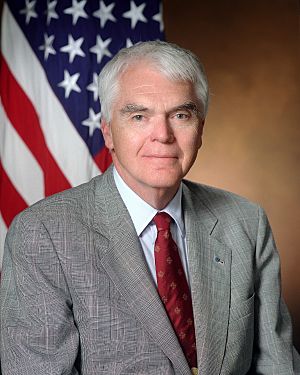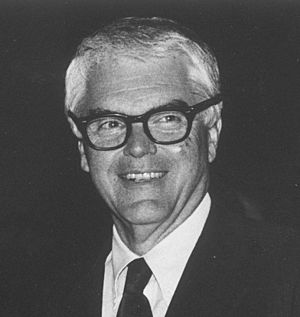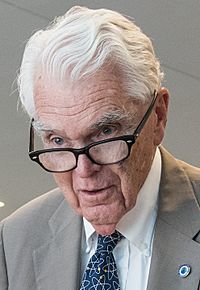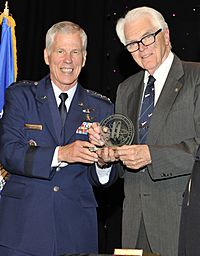Hans Mark facts for kids
Quick facts for kids
Hans Mark
|
|
|---|---|

Mark in 1998
|
|
| 13th United States Secretary of the Air Force | |
| In office May 18, 1979 – February 9, 1981 Acting: May 18, 1979 – July 26, 1979 |
|
| President | Jimmy Carter |
| Preceded by | John C. Stetson |
| Succeeded by | Verne Orr |
| 7th Director of the National Reconnaissance Office | |
| In office August 3, 1977 – October 8, 1979 |
|
| President | Jimmy Carter |
| Preceded by | Thomas C. Reed |
| Succeeded by | Robert J. Hermann |
| Personal details | |
| Born |
Hans Michael Mark
June 17, 1929 Mannheim, Baden, Germany |
| Died | December 18, 2021 (aged 92) Austin, Texas, U.S. |
| Education | University of California, Berkeley (BS) Massachusetts Institute of Technology (MS, PhD) |
Hans Michael Mark (born June 17, 1929 – died December 18, 2021) was an important American government official. He was born in Germany. Mr. Mark worked as the Secretary of the Air Force and also as a top leader at NASA. He was very knowledgeable about designing things for space and airplanes. He also knew a lot about how the country protects itself.
He retired in 2014 from teaching aerospace engineering at the University of Texas at Austin.
Contents
Early Life and Education
Hans Mark was born in Mannheim, Germany. His family lived in Vienna for a while. They had to escape the Nazi Anschluss (when Germany took over Austria) by going through Switzerland. Before France fell during World War II, his family moved to London.
Hans's father, Herman Francis Mark, was a famous chemist who studied polymers (large molecules). He got a job with a paper company in Canada. The family joined him there in late 1939. About a year later, they moved to the United States. They settled in Brooklyn, New York, after his father became a professor at the Polytechnic Institute of Brooklyn.
Hans became an American citizen in 1945. He graduated from Stuyvesant High School in New York City in 1947. He then earned a bachelor's degree in physics from the University of California, Berkeley in 1951. He continued his studies and received a Ph.D. (a high-level degree) in physics from the Massachusetts Institute of Technology (MIT) in 1954.
Early Career in Physics
After getting his Ph.D., Mark stayed at MIT. He worked as a research associate and led the Neutron Physics Group Laboratory for Nuclear Science. In 1955, he returned to the University of California, Berkeley. He worked there as a research physicist at the Lawrence Berkeley National Laboratory until 1958.
Mark then went back to MIT as an assistant professor of physics. In 1960, he returned to the University of California's Livermore Radiation Laboratory. He worked in the Experimental Physics Division until 1964. After that, he became the chairman of the university's Department of Nuclear Engineering. He also managed the Berkeley Research Reactor.
Mr. Mark also taught college classes. He taught physics, engineering, and management at Boston University, the University of California, Davis, and Stanford University.
Working for the U.S. Government
In February 1969, Hans Mark became the director of NASA's Ames Research Center. This center is in Mountain View, California. In this role, he managed research about airplanes, space science, life science, and space technology.
He later served as the Under Secretary of the United States Department of the Air Force from 1977 to 1979. In July 1979, he was promoted to United States Secretary of the Air Force. At the same time, he was also the Director of the National Reconnaissance Office. This office was secret at the time. He held these positions until 1981.
In 1981, President Reagan appointed him as the Deputy Administrator of NASA. He served in this important role from July 1981 to September 1984. Later, in 1999 and 2000, he returned to the Pentagon. There, he worked as the Director of Defense Research and Engineering (DDR&E).
Leadership at the University of Texas
After leaving NASA in 1984, Mark became the Chancellor of the University of Texas system. He held this leadership position until 1992. After that, he became a senior professor of aerospace engineering at the University of Texas at Austin.
In July 1998, he went back to The Pentagon. President Clinton chose him to be the Director of Defense Research and Engineering. In 2001, he returned to the University of Texas at Austin. He held a special teaching position called the John J. McKetta Centennial Energy Chair in Engineering. He was also a professor in the Department of Aerospace Engineering and Engineering Mechanics. He also worked at the University of Texas' Applied Research Laboratories.
Hans Mark retired from teaching at the University of Texas at Austin on July 1, 2014. The university's leaders voted him a Professor Emeritus of Aerospace Engineering and Engineering Mechanics. This title is given to retired professors who have done outstanding work.
Awards and Recognition
Hans Mark was a member of the National Academy of Engineering. This is the highest honor for engineering professionals in the United States. He was also an Honorary Fellow of the American Institute of Aeronautics and Astronautics.
He received several awards for his achievements. These included the 1999 Joe J. King Engineering Achievement Award and the 1999 George E. Haddaway Medal for Achievement in Aviation. In 2006, Dr. Mark was honored for his work on the U.S. military space program. He received the 2006 Military Astronautics Award.
In 2008, the Space Foundation gave Mark its highest honor. This was the General James E. Hill Lifetime Space Achievement Award. This award recognizes people who have made amazing contributions to humanity. These contributions come from exploring, developing, and using space.
In 2012, the Air Force Space Command gave him the Air Force Space and Missile Pioneers Award. This award celebrates people who played a big part in the history of Air Force space and missile programs.
Later Life and Passing
Hans Mark passed away from progressive dementia in Austin, Texas. He died on December 18, 2021, at the age of 92.




